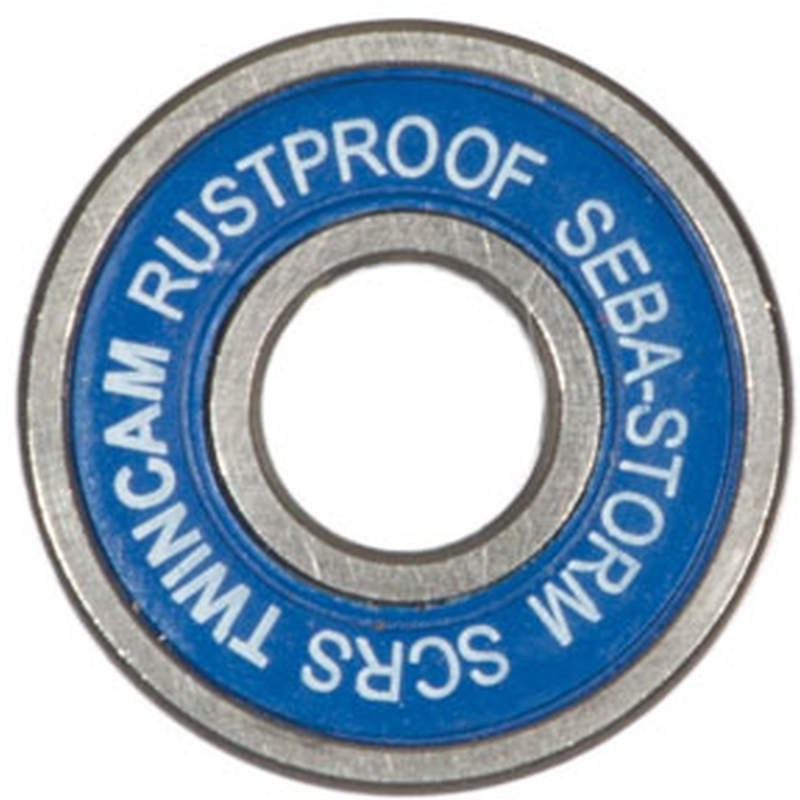
TL;DR: use these stainless steel bearings to skate in the rain.

Most bearings are made of chrome steel, which can corrode. If you once accidentally drove through a puddle, you don't have to worry too much. Usually they won't get stuck or start to rust from getting wet accidentally. But if you sometimes skate in a heavy rain, you should use stainless steel or (semi-)ceramic bearings.
If you however did ride through the rain with chrome steel bearings, you can save them by cleaning them immediately after returning home. (By cleaning I don't mean wiping off the dust, but degreasing them internally and lubricating them again. These products can help: The Wash, Bio Cleaner and lubricant). Of course, most people don't feel like cleaning 16 bearings after every ride in the rain. And for those who use their skates as a means of transport to work, it is completely impossible.
For the rain, you need stainless steel or ceramic bearings. Which of these is best for you?
Ceramic bearings are not only suitable for use in the rain, they are also simply the fastest bearings available, even on dry road surfaces. Ceramic bearings are used always in inline skate races. They are also maintenance friendly. If you need to clean them, they are very easy to clean with compressed air because there is no or very little lubricant in them.
We would like to mention two things about ceramic bearings. Firstly, they are a lot more expensive than stainless steel bearings. Especially when you compare the purchase prices. (If you calculate the price per kilometre that they last, it's not that bad, on the contrary). Secondly, they are less suitable for those who like to jump off stunt obstacles. In that way you can break the ceramic bearing balls. (Just to be clear: you can of course jump off an obstacle without fear while riding. What we mean is that they are not the most suitable bearings for practising, for example, a difficult jump over the two-metre ramp.)
Stainless steel bearings are suitable for sliding, jumping, in short for freeriding. In terms of materials, stainless steel is not as hard as chrome steel, but in practice you don't notice much of that. (This is expressed very cautiously; I personally have never noticed anything about it). The stainless steel of the storm bearings ensures that it does not rust. The outer and inner ring are also extra stepped so that dirt and water are more difficult to penetrate. And a special water-repellent grease has been used as a lubricant.
In practice these stainless bearings are as fast as “normal” bearings. The loss of speed is negligible. Without a chronometer you will not be able to tell whether there are stainless steel or chrome steel bearings under your skates. (The first two minutes you skate, you may notice a difference because there is grease instead of oil in the bearing and that grease has to heat up a bit before it gets the same lubricating properties as oil, but that applies to all bearings with grease, not just the stainless steel bearings). Only for speed races I advise against stainless steel bearings. After all, in a race it is about tenths of a second.
Many persons can do a few years with one set of stainless steel bearings without ever looking at them. However, those who, like yours truly, often skate in the rain in the dark on unknown and poorly lit roads, occasionally end up on a dirt road that looks like a beautiful asphalt track from afar in the dark. With such a pattern of use, dirt gets into the bearings anyway. Then it is best to make sure you have two sets of stainless steel bearings at home. If some of the bearings get stuck, simply put them aside and replace them with the clean bearings of the other set. The dirty bearings can be stored until it is worth the time cleaning them all at once. They don't rust anyway, so they can be left uncleaned for a while. (If you have a tri-skate, you automatically have 4 spare bearings with the box of 16 bearings.)
Other methods of protecting your bearings from the rain do not work.
On the internet, for example, you can find the advice to skate in the rain with ordinary bearings and make them dry after returning home by freewheeling them for two minutes by spinning them around with your hand. All the moisture would then be centrifuged out of the bearings. The reality is that this does not work, even if you let them freewheel for two hours. Maybe that tip comes from a Californian guy, who associates rain with pleasant, warm droplets that provide drinking for the cactuses and palm trees along Venice Beach. If you skate with ordinary, non-rain bearings in real, pouring rain, there's soon more water in the bearing than lubricant. By freewheeling them, the lost oil will not miraculously come back.
Using cheap bearings with a closed casing with the intention of replacing them as a disposable product with a new one as soon as they get stuck, is not a good idea either. After or even during the first modest downpour, most bearings will already jam and be broken.
The product has been added to your cart.
There are no products left.
The product has been added to your wishlist.
Something went wrong.
The desired quantity of this product is at this moment available. No email will be sent.
No user has been linked yet to this wishlist. For this functionality, please log in, then an email address is linked to this wishlist. If you don't have a login yet, please register. Only an email address is necessary to register/log in. Only at the checkout an address is required!